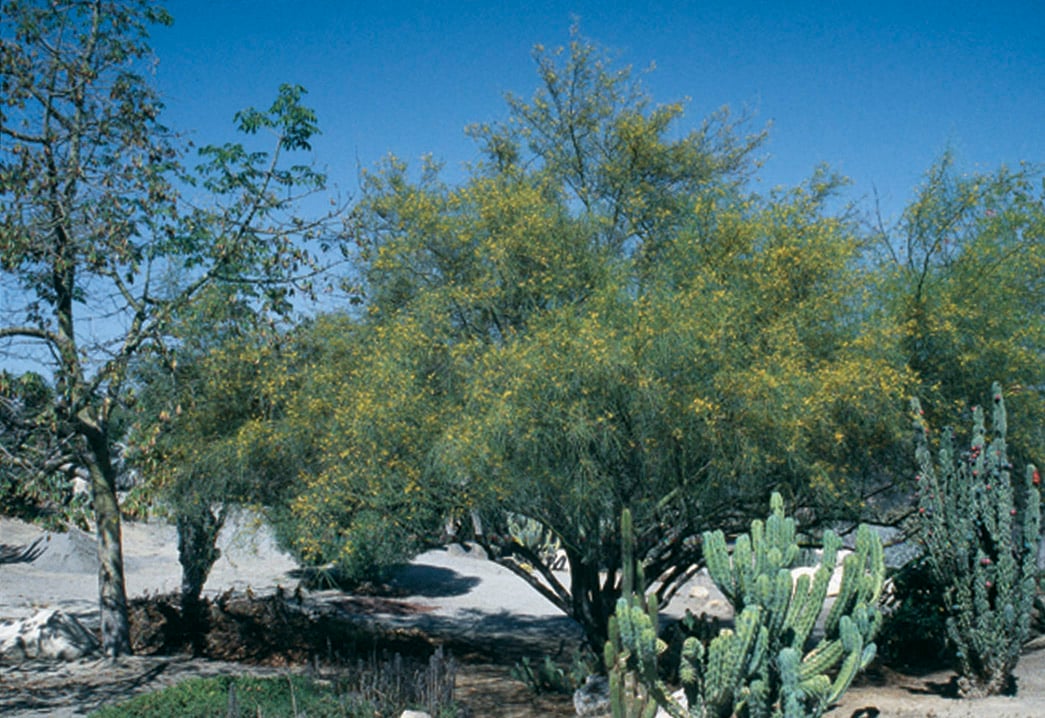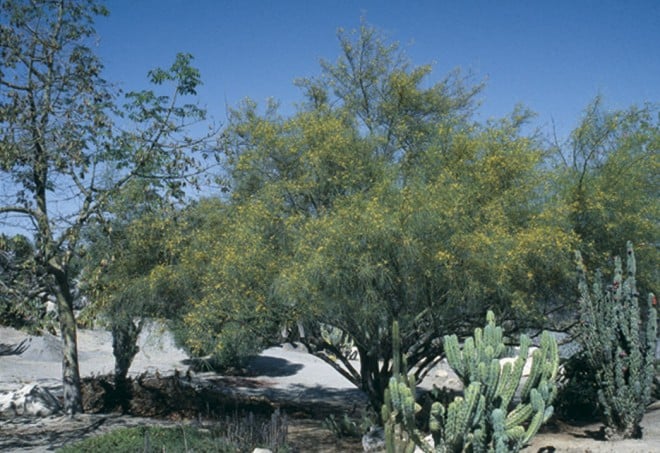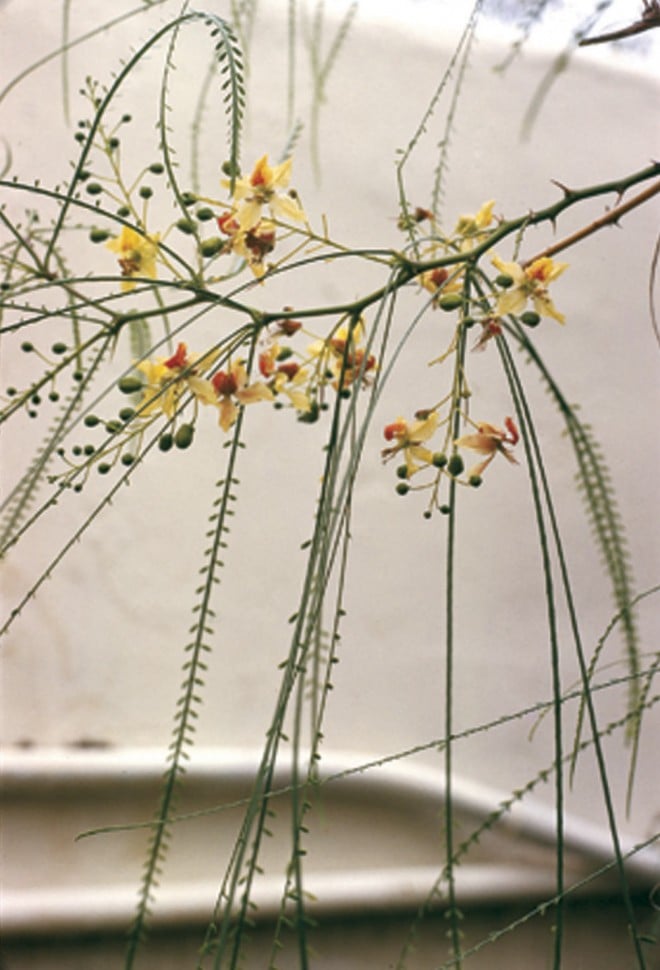
Mexican Palo Verde

Contributor

Valued for its tolerance of both soil and climate extremes, Mexican palo verde (Parkinsonia aculeata) has long been cultivated as an ornamental tree in warm climates throughout the world. Along the way, however, it has developed a split personality. As a garden tree in some regions (coastal Southern California, for example), it is a beautiful and easy drought-tolerant small tree with few faults. But in many other areas of the world (notably in parts of Australia), it grows too easily, and has become a horrible weed that threatens entire indigenous ecosystems. So, depending on who you’re talking to when you say the words “palo verde,” you may be met with either smiles or screams!
Good Tree
Although it will tolerate regular watering, Mexican palo verde is one of the few ornamental trees that can grow in Southern California gardens without supplemental irrigation. A member of the legume family, it grows quickly at first, then slows to an eventual fifteen to twenty-five feet tall and wide with a graceful, spreading habit and picturesque form.
The sparse, “see-through” foliage of the Mexican palo verde is bright yellow green, composed of thorny branchlets and six- to nine-inch-long compound leaves with many tiny leaflets. These leaflets are shed quickly in drought or cold, leaving just the midribs of each leaf persisting on the tree. Flowering is showy, with three- to seven-inch-long clusters of half-inch, fragrant yellow blossoms produced over a long period in the spring and sporadically at other times of the year. Flowers are followed by two- to six-inch-long tan seedpods.
Mexican palo verdes are tolerant of almost any type of soil, even strongly alkaline ones. They are also tolerant of excessive heat as well as temperatures as low as 15° F. Because of its finely textured foliage, the filtered shade cast by this tree allows for the growth of many kinds of drought-tolerant plants underneath it, and it can be spectacular as a centerpiece tree in a cactus and succulent garden. The Sunset Western Garden Book lists Mexican palo verde as successful in Sunset zones 8-24 and in Hawaii; it also grows successfully in many parts of the southern United States. This tree is particularly adapted to desert climates, although its propensity to reseed itself aggressively in hot areas should make desert gardeners think twice about planting it.

Bad Tree
Mexican palo verde now grows wild in so many countries that it is difficult to pinpoint exactly where it was originally native. From its presumed origins in the southwestern United States and Mexico, it has now spread (with some human help) and is naturalized in Central and South America and in such far-flung areas as Florida, Australia, Africa, Pakistan, the Galapagos Islands, Guam, New Caledonia, and even Hawaii. In its travels around the world, Mexican palo verde has acquired a host of other common names, including Jerusalem thorn, retama, horsebean, cloth of gold, crown of thorns, Barbados fence flower, and even jellybean tree. In parts of the world where it is considered a weed, there are probably other (perhaps unprintable) common names as well.
Although Mexican palo verde is a mild mannered Dr Jekyll in coastal Southern California gardens, it can be an aggressive Mr Hyde in hot desert climates. Since both its growth and seed production are markedly stronger where temperatures are high, in some parts of the world where it has been introduced, it has become a weed species that can overwhelm weaker indigenous plants. In order to protect sensitive natural ecosystems in areas where this tree is weedy, eradication efforts are underway; in Australia, a seedeating beetle introduced from Argentina is providing some promise for long-term control.
Better Tree
Few kinds of trees are as adaptable to desert life as Mexican palo verde, so wouldn’t it be helpful if desert gardeners had a less weedy selection of palo verde? Fortunately, such a tree exists in Parkinsonia (formerly Cercidium) ‘Desert Museum’. Introduced in 1987 by the Arizona Sonora Desert Museum in Tucson, this tree is reputedly a natural hybrid involving P. aculeata and two other Sonoran Desert species, P. microphylla and P. florida, both formerly in the genus Cercidium
‘Desert Museum’ palo verde combines the best features of all three of these desert species, and, most importantly, produces few seeds. Growing quickly to twenty feet tall and wide, it has a longer spring and summer bloom season than Mexican palo verde, larger, inch-wide flowers, more graceful, brighter green foliage with no thorns, a showy limegreen trunk, and is cold-hardy to 17° F. Not surprisingly, this beautiful small tree has now become one of the most popular choices for desert landscapes throughout the Southwest; it also grows well in other warm-summer climates of Central and Southern California.
Adapted with permission from Ornamental Trees for Mediterranean Climates: The Trees of San Diego, published in 2006 by the San Diego Horticultural Society.
Share:
Social Media
Garden Futurist Podcast
Most Popular
Videos
Topics
Related Posts

Ground Up Science for Greener Cities with Garden Futurist Dr. Alessandro Ossola
Spring 2023 Listen to the Podcast here. Alessandro Ossola is a scientist who gets very excited about the challenge of climate change allowing for an

Readying Urban Forests for Climate Realities with Garden Futurist Dr. Greg McPherson
Winter 2023 Listen to the Podcast here. “Going from the mow and blow to a more horticulturally knowledgeable approach to maintaining the landscape. And that

Welcome, Greywater, to the Garden
Summer 2022 Oh, summer: delightful warm air, tomatoes swelling on the vine, fragrant blooms on an evening stroll. When it’s warm and rainless, how is

Big Tree-Data and Big-Tree Data with Garden Futurist Matt Ritter
Summer 2022 Listen to the full Garden Futurist: Episode XV podcast here. We are in an environmental crisis right now in many parts of California










Responses